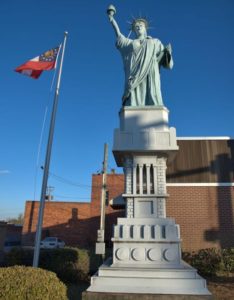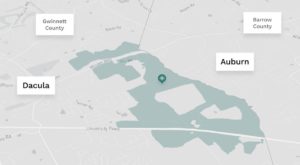GwinnettForum | Number 21.98 | Dec. 17, 2021
GWINNETT TECH’S NEW BUILDING going up alongside Georgia Highway 316 is for the Computer Information Systems, Cybersecurity, and Emerging Technologies programs. It’s expected to open in the spring of 2023. Also going on now is renovation of campus Building 100 and other improvements. Total cost of the overall project is $37.8 million, with work being done by Winter Construction Company, and The Sizemore Group as architects. This structure will be 83,000 square feet and includes 29 classrooms.
TODAY’S FOCUS: UGA team releases historical and cultural report on Rowen site
EEB PERSPECTIVE: My first real work under frantic and constant pressure
ANOTHER VIEW: Time for radical change in USA concerning drug policy
SPOTLIGHT: MTI Baths Inc.
FEEDBACK: Hard to justify $50 monthly bill for newspaper subscription
NOTABLE: GAC’s Rachel VanderPol among top volleyball coaches under 30
RECOMMENDED: The Moving Finger by Agatha Christie
GEORGIA TIDBIT: Rivers’ four years as governor gained mixed reviews
MYSTERY PHOTO: This photograph will give you chill bumps in winter
CALENDAR: Redistricting open houses to be on December 17 and 20
UGA team releases historical, cultural report on Rowen site
By Brian Brodrick
LAWRENCEVILLE, Ga. | A team of researchers from the University of Georgia’s College of Environment and Design spent months earlier this year combing the nearly 2,000 acres in rural Gwinnett County that is the future site of Rowen, slated to become one of the nation’s premier innovation communities over the next few decades.
The resulting study, called the “Rowen Historical and Cultural Report,” was written by Dr. Mark Reinberger and Prof. Dan Nadenicek, and is shared by the Rowen Foundation. The report will help ensure that the Foundation, which manages the project, will carefully honor the history of the site as it plans its future.
Mason Ailstock, president of the Rowen Foundation,says: “As stewards of Rowen, we take our responsibility seriously to honor and preserve as many of the site’s historic assets as possible. We are grateful to the College of Environment and Design for providing this detailed resource as we plan Rowen.”
Rowen will be a knowledge community that operates at the intersection of business, innovation and research. The Rowen Foundation engaged the College of Environment and Design to honor two of the community’s core values, stewardship and sustainability, while providing a full picture of the site’s significance to Georgia history as planning began for the project.
The report also allows the Foundation to understand the evolution and impact of Rowen’s programmatic drivers – agriculture, medicine and the environment – on the land over past generations.
The report’s research and recommendations will be used to preserve, enhance, and celebrate the site’s historical and cultural features. These include historic sites, remnants of past historic structures, remains of an historic mill, two historic homes, and landscape features that includes one of Gwinnett’s oldest dirt roads.
The report’s findings have also been layered into a multi-faceted analysis of the site – including sensitive environmental areas, tree canopy, waterways and others – that inform intensity, density, roadway design and areas of the site that may or may not be developed over the project’s more than 50 year buildout.
The collaboration was also one of the first formal partnerships between Rowen and University System of Georgia researchers. A key goal for the Rowen Foundation is to be a vehicle for collaboration and innovation between academics and the community.
Rowen is working in close coordination with Gwinnett County to explore the recommendations outlined in UGA’s report.
Tina Fleming, director of the Gwinnett County Department of Community Services,says:
“The Rowen report provides valuable insights into the history of the Rowen lands. Gwinnett County looks forward to partnering with the Rowen Foundation in identifying and celebrating valuable community assets at the site.”
Additional findings from the report emphasize the importance of existing structures and environmental points of interest such as connection to the Apalachee River and natural walking trails. With the report’s recommendations for the careful management of the historical features of the site, the Rowen Foundation hopes to honor the legacy of this land, which is deeply embedded in Gwinnett County already.
Reinberger and Nadenicek worked with three graduate students from the college to conduct the research. The team was joined by Dacula native Caroline Hinton and utilized resources from the Gwinnett County Historical Society.
- The report can be viewed on Rowen’s website at https://www.rowenlife.com/announcement/historicalculturalreport/.
- Have a comment? Send to: elliott@brack.net
My first real work was under frantic and constant pressure
By Elliott Brack
Editor and Publisher, GwinnettForum
DEC. 17, 2021 | It doesn’t hurt to be under pressure to see how you fare.
![]() Now what to me seems tame these days was right up there in a pressured situation back in my early days in a newsroom. It was the first Friday night in September with me just starting to work on The Macon Telegraph, the morning newspaper. Previously I had been on the afternoon paper, and moved to the a.m. paper on Labor Day.
Now what to me seems tame these days was right up there in a pressured situation back in my early days in a newsroom. It was the first Friday night in September with me just starting to work on The Macon Telegraph, the morning newspaper. Previously I had been on the afternoon paper, and moved to the a.m. paper on Labor Day.
The week was routine, with me covering the “police beat,” checking stories at the sheriff’s office, the Macon police and the hospital. That didn’t prepare me for what I suddenly faced Friday night…..when the telephones started ringing off the hook about 9:45 that night.
Persons on the scene at high school football games started calling in their reports, as the phones kept ringing one-after-the-other for the next hour and a half. Everybody in the newsroom, about 15 of us, suddenly became sports writers, taking notes from those correspondents at the game site, getting not just the scores, but the highlights as seen by those at the game, then compiling the important box score per quarters, and if time, who and how players scored.
You might imagine all these guys (no ladies then) talking at once to high school correspondents, having difficulty hearing, and working to accurately gather the details. And we had to do it by about 11:15, the deadline for the down state edition.
In those days, towns circling Macon from as far north as Forsyth, Monticello and Eatonton, as far east as Milledgeville and Sandersville, then south to Vidalia, Lyons, Dublin and Fitzgerald, over to Cordele, Perry and Fort Valley….and all those towns in between, were the Telegraph’s coverage map. People in each of those towns and others wanted to see their team’s score, but also wanted to see what their regional competitors in other towns were doing.
Our job was to get the scores reported, so the presses could roll on time to get those papers to these distant cities by the morning. People would be waiting!
So yes, the entire male reporting staff, including the copy editors, the news editor, and even the managing editor himself, would be manning telephones. It was an intense period, and for me that first week on the job, I was bamboozled after experiencing this new wrinkle.
Once the papers started off the press, a bundle came immediately to the newsroom and we each checked out stories….for errors. Sometimes we had to stop the press and put in a correction, a costly and time-consuming process. We made sure we got it right.
The telephone was the main connector with distant reporters back then. Even the capitol reporter in those days, who was Reg Murphy, would phone in his report of the Legislature action about 7 p.m. at night. Whoever was free in the newsroom took his dictation, me often included. I had known Reg from Mercer days. He later became editor of the Atlanta newspapers, then famous when he was kidnapped. He then became the publisher in San Francisco and Baltimore, and later head of the National Geographic Society and the U.S. Golf Association. He’s retired at Sea Island today.
Even Reg was once a Friday night sports reporter taking notes from distant correspondents. That was a place where your writing was under pressure….and it made you a better newsman, this working under pressure.
- Have a comment? Send to: elliott@brack.net
Time for radical change in USA concerning drug policy
(Editor’s note: This is the first contribution by this author. He is originally from Carrollton and is a retired English teacher of 30 years and taught at Carrollton, Buford, South Gwinnett, and for the last 24 years at North Gwinnett. He was also a debate coach. He now lives in Duluth.—eeb.
By Michael Blackwood
DULUTH, Ga. | Let me first add that I hate to say this, but in the interest of our citizens and as justified by the preamble of the Constitution, I believe it is time for a radical change in the United States’ drug policy. It is time to not only legalize drug use, but for the government to supply it.
The problems police have with dealers at all levels, as well as the crimes committed by users, take disproportionate time and money. Note now that we have police forces who believe, with reason, that they need to be more militarized to deal with the problems in many areas of major cities. They see entire regions in Mexico under the armed control of cartels. These cartels exist almost exclusively on the illegal drug use of U.S. citizens. Without money from our users the cartels will dry up, a help to our country and to Mexico.
I would propose that we maintain and run first-class rehab programs. We should increase their numbers, but ensure they are not generic but geared to specific types of addiction. I would have a system where anyone could present themselves to be reviewed by an appropriate committee and, if confirmed as an addict, receive the drugs free of charge from clinics in their area. Doctors should determine the maintenance level and give nothing more.
Sounds simplistic, I know. However, this isn’t a monograph, but merely a brief outline. If we eliminate the market for drugs in our country, the Central and South American governments have a chance of regaining control of their countries. There would be no market mechanism to enlist users in America. If the user becomes addicted, the user gets free drugs for personal use.
This leaves the problems of teenagers, especially with ecstasy and fentanyl. Those are cheap party drugs outside the main problem. However, they apparently come in through the same supply lines as other drugs. Cutting the amount will at least help. I’m sure other people smarter than me can address that problem.
I know this idea is naïve, considering political will. We can’t even have a K-12 sex education program like most of the developed world. Our citizens and politicians can’t accept that we have problems that won’t go away.
Of course, many high-class and ritzy neighborhoods are dependent on the drug money to support the oversized homes. I remember growing up when most of the counties here were “dry.” People would say that legal alcohol was opposed by “preachers and bootleggers.”
Nothing has changed.
- Have a comment? Send to: elliott@brack.net
MTI Baths Inc.
 The public spiritedness of our sponsors allows us to bring GwinnettForum.com to you at no cost to readers. Today’s featured sponsor is MTI Baths Inc. of Sugar Hill. MTI Baths is a manufacturer of high-quality acrylic and engineered solid surface bath products, including whirlpools, air and soaking baths; lavatories; shower bases; and kitchen sinks.
The public spiritedness of our sponsors allows us to bring GwinnettForum.com to you at no cost to readers. Today’s featured sponsor is MTI Baths Inc. of Sugar Hill. MTI Baths is a manufacturer of high-quality acrylic and engineered solid surface bath products, including whirlpools, air and soaking baths; lavatories; shower bases; and kitchen sinks.
 MTI’s patented Fill-Flush® and Simple Touch® whirlpool cleaning systems are the best on the market. MTI now offers engineered solid surface–countertops and sinks. Every product is custom-made to order. We are now operating in an additional manufacturing plant of 38,000 square foot. CEO of the firm is Kathy Adams, while Russell Adams is president. MTI Baths was excited to be the project management for the Georgia Tech KOAN Project, John Portman’s final design of a sculpture. (See photo at left).
MTI’s patented Fill-Flush® and Simple Touch® whirlpool cleaning systems are the best on the market. MTI now offers engineered solid surface–countertops and sinks. Every product is custom-made to order. We are now operating in an additional manufacturing plant of 38,000 square foot. CEO of the firm is Kathy Adams, while Russell Adams is president. MTI Baths was excited to be the project management for the Georgia Tech KOAN Project, John Portman’s final design of a sculpture. (See photo at left).
- Visit their web site at http://www.mtibaths.com/.
- For a list of other sponsors of this forum, click here.
Hard to justify $50 monthly bill for newspaper subscription
![]() Let me agree with your comments about the state of the newspaper business.
Let me agree with your comments about the state of the newspaper business.
After the latest redesign of the Atlanta newspapers, it is getting hard to justify on retirement income the $50/month the AJC wants for home delivery. I am hanging with it because of my life-long habit of reading the newspaper with breakfast.
Even with its faults, the Gwinnett Daily Post does a better job covering Gwinnett and I would gladly give them AJC’s subscription money to go back to four editions per week.
What I find most annoying is the amount of self-promoting filler, summaries with bullet points and photo captions that have the exact same word-for-word text as in the article. And then, of course, as you mentioned, the long articles, especially ones with sidebars recounting the timeline of the events. How many times did we need to know the sequence of events in the Arbery case?
It’s as if every article was written to assume the reader had never heard anything about the situation before. It is nauseatingly repetitive, and took up so much room that could have been used for other news. (That’s another peeve.)
I’ve also found instances of the same article in the paper twice, or re-printed the next day. Do they do that on purpose because they didn’t have anything else to fill that space?
I do a lot of research using newspaper archives, and it breaks my heart to compare newspapers of today to those of the past.
– Tom Fort, Snellville
Thanks for advocating for those held hostage by govt.
Thank you for continuing to shed light on the newspaper business, and advocating for those held hostage by our system, as Jack Bernard pointed out in the last edition of GwinnettForum.
– Darrell Pruitt, Sugar Hill
Newspapers and high-button shoes had a good run
Many influences have reduced the value of our local newspapers. But there seems to be an inevitability to their demise.
News printed 8-10 hours before it hit our front porch is “old news.” Social media, Yahoo, Apple, etc. could give us current happenings…often up to the very second.
Although the classifieds were devastated by technology for jobs, real estate, cars, etc., there is also a corollary in the continual decline in department stores, who relied on newspapers to get the word out with massive buys. Newspaper management seemed to turn a blind eye to new news outlets one could get on their phone or laptop, deciding to “give” content away, while only later realizing that was a likely revenue goldmine for peoples’ changing tastes. Look at The NY Times and Washington Post success.
But newspapers have had a long and profitable run, like the horse and buggy, high-buttoned shoes, and the radio. But the times and peoples’ needs have changed…
– Howard Hoffman, Berkeley Lake
Send us your thoughts: We encourage you to send us your letters and thoughts on issues raised in GwinnettForum. Please limit comments to 300 words, and include your hometown. The views of letters are the opinion of the contributor. We reserve the right to edit for clarity and length. Send feedback and letters to: elliott@brack.net.
GAC’s VanderPol among top volleyball coaches under 30
The past two years have been notable for Coach Rachel VanderPol of Greater Atlanta Christian School (GAC). Recently she was named as one of the top 30 under 30 High School Coaches by the American Volleyball Coaches Association (AVCA).
Coach VanderPol started as a soccer player but was introduced to volleyball during high school days. She continued developing her skills playing for an A5 Volleyball Club and then at Liberty University. In her first-year coaching at GAC in 2019, she stunned the competition by advancing to the Final Four. This past year, the team became State champions.
She says: “My goal as a coach is to help each athlete improve from a skill standpoint in their sport and as a person. Gaining life lessons such as how to work together on a team, be committed and accountable to others, and how to support and encourage those around you are lessons that go far beyond the sport of volleyball.”
Coach VanderPol quickly gives credit to her dynamic and talented players, their families, and the expertise and support of the assistant coaches. She adds: “I am so thankful for each of them and the role they have played in my life, personally. Volleyball is a game we play and we want to be the best we can at it, but it is not who we are. I hope players leave our (GAC) program as better athletes and as better people who are on fire for Christ.”
- Have a comment? Send to: elliott@brack.net
The Moving Finger by Agatha Christie
![]() From Susan McBrayer, Sugar Hill: When young veteran Jerry Burton rents a charming home in a tranquil, country village, his expectations of a peaceful convalescence from a war wound are disturbed when he receives a ‘poison pen’ letter. The letter accuses his sister, who is accompanying him, of not being his sister at all but a promiscuous tart. Gradually Burton discovers that half the village has been plagued with similar disturbing letters. Things really begin to go downhill when the wife of the local solicitor is found dead in her bed with a suicide note nearby. So much for peace and quiet! Village gossip and suspicions abound and eventually Miss Marple shows up to put two and two together. Narrated by Burton, this tale does not have the breathless excitement of today’s modern thrillers but presents an entertaining, lighthearted puzzle in the much-admired style of the Golden Age of Detective Fiction.
From Susan McBrayer, Sugar Hill: When young veteran Jerry Burton rents a charming home in a tranquil, country village, his expectations of a peaceful convalescence from a war wound are disturbed when he receives a ‘poison pen’ letter. The letter accuses his sister, who is accompanying him, of not being his sister at all but a promiscuous tart. Gradually Burton discovers that half the village has been plagued with similar disturbing letters. Things really begin to go downhill when the wife of the local solicitor is found dead in her bed with a suicide note nearby. So much for peace and quiet! Village gossip and suspicions abound and eventually Miss Marple shows up to put two and two together. Narrated by Burton, this tale does not have the breathless excitement of today’s modern thrillers but presents an entertaining, lighthearted puzzle in the much-admired style of the Golden Age of Detective Fiction.
- An invitation: what books, restaurants, movies or web sites have you enjoyed recently? Send us your recent selection, along with a short paragraph (150 words) as to why you liked this, plus what you plan to visit or read next. Send to: elliott@brack.net
Rivers’ four years as governor gained mixed reviews
E.D. (“Ed”) Rivers served consecutive two-year terms as Georgia’s governor(elected in 1936 and reelected in 1938). In his first term, Rivers brought a “Little New Deal” to Georgia and presided over a significant expansion of state services. By the end of his second term, Rivers and his administration were awash in charges of corruption. Rivers gained the governorship initially as the anti-Talmadge, pro–New Deal candidate. Yet he used many of the same heavy-handed tactics that his predecessor had made infamous, including the use of the National Guard to resolve political disputes with state agencies. Even when Rivers attempted to return to the governor’s office in 1946, his candidacy served mainly to tilt the race toward Eugene Talmadge.
 Eurith Dickinson Rivers was born on December 1, 1895, in Center Point, Ark., to Millie Annie Wilkerson and James Matthew Rivers. He attended Young Harris College, where he met Mattie Lucille Lashley. The two married in 1914 and had two children, Eurith Dickinson Jr. and Geraldine. Rivers earned a law degree from LaSalle Extension University in Illinois in 1923.
Eurith Dickinson Rivers was born on December 1, 1895, in Center Point, Ark., to Millie Annie Wilkerson and James Matthew Rivers. He attended Young Harris College, where he met Mattie Lucille Lashley. The two married in 1914 and had two children, Eurith Dickinson Jr. and Geraldine. Rivers earned a law degree from LaSalle Extension University in Illinois in 1923.
The Rivers family settled in Cairo, in Grady County. Soon, Rivers became a justice of the peace, city attorney for Cairo, and attorney for Grady County. He then moved to Milltown (later Lakeland) and became editor of the Lanier County News.
He was elected to the Georgia House of Representatives in 1924 and to the state senate in 1926. Like many of Georgia’s rural county leaders, Rivers was active in both the state legislature and the Ku Klux Klan. Despite his surface similarities to the typical Georgia county leader in the period, his biographer describes Rivers as “polished and urbane.” Rivers seemed genuinely concerned for the plight of Georgia’s poor farmers and eventually sought to use the power of government to help them. Politicians like Eugene Talmadge, in contrast, generally opposed state and federal aid programs but were able to connect emotionally with the “wool hat boys.”
Rivers served as speaker of the Georgia House of Representatives from 1933 to 1935 and nominally supported Governor Talmadge. Rivers did not share the governor’s ingrained conservatism, however. Talmadge loudly opposed and obstructed Georgia’s participation in a number of New Deal programs, instead promoting self-reliance and private charity as the answer to Georgia’s Depression-era economic ills.
With the popular Talmadge barred from seeking a third consecutive term in 1936, Rivers grasped his opportunity. He openly endorsed the very New Deal programs that Talmadge had opposed and promised more vigorous state government action to promote education, public health, and economic development.
Rivers pursued an ambitious agenda in his first term. He convinced the legislature to enact legislation making it possible for Georgia to receive federal funds for public housing and rural electrification, measures that Talmadge had blocked. By the end of Rivers’s second term, Georgia had received more than $17 million in federal funds for rural electrification projects alone.
Rivers initiated an active program of state-level government action as well. He convinced the legislature to create independent authorities with the power to sell bonds and incur debt. This was a cumbersome but effective way to allow the state to avoid the constitutional prohibition on state indebtedness, while still borrowing money to fund important public projects.
(To be continued)
- To view the Georgia Encyclopedia article online, go to https://www.georgiaencyclopedia.org
This photograph will give you chill bumps in winter
Today’s Mystery Photo doesn’t look like a place to visit on a winter’s day. Yep, it’s a beach, but where? Send your answer to elliott@brack.neet, and include your hometown.
 The most recent Mystery Photo was a refreshing story of ingenuity on the part of a Lions Club in McRae, Ga. Several readers researched the photo, and came up with the right answer. The photo came from Brian Brown of Fitzgerald in his “Vanishing Georgia” series.
The most recent Mystery Photo was a refreshing story of ingenuity on the part of a Lions Club in McRae, Ga. Several readers researched the photo, and came up with the right answer. The photo came from Brian Brown of Fitzgerald in his “Vanishing Georgia” series.
Jane Bane of Lawrenceville told us: “This photo of Lady Liberty is in the Telfair County War Memorial in McRae, GA. There is also a replica of the Liberty Bell in the memorial park in McRae.” Others recognizing the photo include Jim Savadelis, Duluth: Raleigh Perry, Buford; Lou Camerio, Lilburn; Susan McBrayer, Sugar Hill; Lynn Naylor, Norcross; George Graf of Palmyra, Va.; and Allan Peel of San Antonio, Tex.
Peel wrote: “Today’s mystery photo is of a 1/12-size replica of the Statue of Liberty at the corner of Golden Isles Parkway and U.S. Highway 280 in downtown McRae, Georgia. Since the original statue in New York is 305-feet tall, this means that the one in McRae is 25-feet tall, from the ground to the tip of the torch.
“It was built in 1976 by the Lion’s Club McRae to celebrate the 200th anniversary of the birth of our country. The club raised the money to build the monument by themselves, but the fund raising was shy on funds, and so they decided to source a lot of the material locally and to make the statue themselves. As such, the original head of the statue was made out of a tree stump that was retrieved from a local swamp, and the hand holding the torch was made from an electrical man’s glove. Styrofoam and a lot of recycled material was used during the construction of the statue. Throughout the years, the statue has had some materials replaced, and is somewhat stronger and more weather resistant now.
“While not visible in the mystery photo, this location, informally known as McRae Liberty Square, is also home to a replica of the Liberty Bell and as well as a World War II Memorial. The Liberty Bell replica was also built using recycled materials, with the basic structure being crafted from an old bell from a local firehouse. And in case you were wondering … yes, the McRae’s Liberty Bell does have a crack in it … created by splitting open the firehouse bell with a sledgehammer. Details are important when crafting replicas!”
Graf adds: “Said Ray Bowers of the Club, “We never knew it would be so pretty.” The green lady is illuminated by spotlights at night.”
![]() Two additional Open Houses concerning redistricting are upcoming by the Gwinnett County Commission for residents to come out, see maps and ask questions about new district lines for Gwinnett County commission districts. Redistricting happens once every 10 years. District 3 Commissioner Jasper Watkins will host two redistricting open houses on two separate days. The meetings are scheduled for:
Two additional Open Houses concerning redistricting are upcoming by the Gwinnett County Commission for residents to come out, see maps and ask questions about new district lines for Gwinnett County commission districts. Redistricting happens once every 10 years. District 3 Commissioner Jasper Watkins will host two redistricting open houses on two separate days. The meetings are scheduled for:
- Friday, December 17, 6: 30 p.m. until 8 p.m. at the Centerville Senior Center, 3025 Bethany Church Road, Snellville; and
- Monday, December 20, 6: 30 p.m. until 8 p.m.at the Dacula Park Activity Building, 2735 Auburn Ave., Dacula.
GwinnettForum is provided to you at no charge every Tuesday and Friday.
Meet our team
- Editor and publisher: Elliott Brack, 770-840-1003
- Managing editor: Betsy Brack
- Roving photographer: Frank Sharp
- Contributing columnist: Jack Bernard
- Contributing columnist: George Wilson
More
- Mailing address: P.O. Box 1365, Norcross, Ga. 30091
- Work with us: If you would like to serve as an underwriter, click here to learn more.
Subscriptions to GwinnettForum are free.
- Click to subscribe.
- Unsubscribe. We hope you’ll keep receiving the great news and information from GwinnettForum, but if you need to unsubscribe, go to this page and unsubscribe in the appropriate box.
© 2021, Gwinnett Forum.com. Gwinnett Forum is an online community commentary for exploring pragmatic and sensible social, political and economic approaches to improve life in Gwinnett County, Ga. USA.














Follow Us